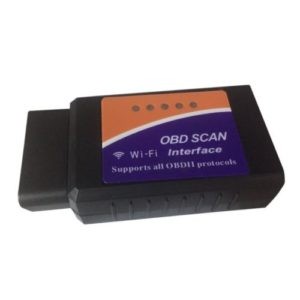For car enthusiasts and everyday drivers alike, understanding your vehicle’s health is becoming increasingly accessible. At the heart of this revolution is the Obd2 Adapter Elm327, a small but powerful tool that bridges the gap between your car’s computer and your smartphone or tablet. Choosing the right ELM327 adapter is crucial for a seamless and effective car diagnostic experience. This guide will delve into everything you need to know to select the best OBD2 adapter ELM327 for your needs, ensuring you get accurate data and a reliable connection every time.
Understanding ELM327 OBD2 Adapters
An ELM327 adapter acts as a translator, converting your car’s onboard diagnostic system (OBD2) data into a format readable by your devices. These adapters communicate wirelessly via Bluetooth, Bluetooth LE, or Wi-Fi, depending on the model and your device’s operating system. You can easily find a wide selection of these adapters online by searching for “elm327 bluetooth” or “elm327 wifi” on platforms like Amazon, eBay, or automotive parts websites.
The adapter you choose is paramount. It determines not only if you can connect to your car’s computer but also the quality and stability of that connection. A well-chosen adapter unlocks a wealth of information about your vehicle’s performance and potential issues, while a poor choice can lead to frustration, inaccurate readings, or even connection failures.
Connection Types: Bluetooth, Bluetooth LE, or Wi-Fi?
When selecting an ELM327 adapter, consider two primary factors: compatibility with your smartphone or tablet and the adapter’s overall quality. The connection type is the first hurdle to clear for compatibility. Adapters typically fall into these categories:
- Wi-Fi: These adapters create their own Wi-Fi network for your device to connect to.
- Bluetooth Classic (Versions 1.x, 2.x, 3.x): The traditional Bluetooth connection, widely supported by Android devices.
- Bluetooth Low Energy (LE) (Version 4.0 and above): Designed for low power consumption, this is the preferred connection for iOS devices and is also compatible with newer Android devices. It’s important to distinguish Bluetooth LE from classic Bluetooth as they are fundamentally different technologies.
- Bluetooth MFi: This is essentially classic Bluetooth, but specifically certified by Apple for seamless integration with iPhones and iPads. These adapters are less common and often pricier due to Apple’s certification process. Examples include OBDLink MX+ and vLinker FS. On Android, they function as standard Bluetooth adapters.
- USB: While USB adapters exist, Car Scanner and many modern diagnostic apps primarily support wireless connections, making USB adapters less practical for smartphone-based diagnostics.
The optimal connection type depends largely on your mobile operating system:
For Apple iOS (iPhone/iPad)
Apple iOS devices, due to operating system restrictions, primarily support Bluetooth LE (4.0), Wi-Fi, and Bluetooth MFi adapters. Classic Bluetooth adapters (versions 1.x, 2.x, 3.x) are not compatible with iPhones or iPads under any circumstances.
Recommendation for iOS: Bluetooth LE (4.0) adapters are generally the best choice for iOS users. They offer a good balance of easy connectivity, reasonable data transfer speeds, and availability. While Bluetooth MFi adapters provide top-tier performance, they come at a premium price. Wi-Fi adapters, while compatible, can sometimes introduce connection complexities and may interfere with your mobile data.
Crucially, verify the Bluetooth version! Many iOS users mistakenly purchase classic Bluetooth adapters, only to find they are incompatible with their iPhones or iPads. This limitation is inherent to the iOS architecture and cannot be bypassed by any app.
For Google Android
Android devices offer greater flexibility, supporting classic Bluetooth (versions 1.x, 2.x, 3.x), Bluetooth LE (4.0), and Wi-Fi adapters. Classic Bluetooth adapters are often recommended for Android. They tend to provide faster data transfer speeds than Bluetooth LE and a more stable connection than Wi-Fi on Android platforms. The majority of Android users successfully utilize classic Bluetooth ELM327 adapters.
However, a potential drawback with classic Bluetooth on Android is the possibility of conflicts when simultaneously connecting multiple Bluetooth devices, such as an OBD2 adapter and a car’s Bluetooth multimedia system.
Quality Matters: Navigating the ELM327 Adapter Landscape
Forget outdated notions about ELM327 adapter versions, internal chips, or circuit board layers. These factors are no longer reliable indicators of quality. Counterfeiters have become adept at mimicking these features, and reputable manufacturers are producing quality adapters with diverse internal components. The true distinction lies in whether an ELM327 adapter is “good” or “bad”.
A “good” adapter performs reliably and consistently, without glitches or freezes. It simply works as intended, providing a stable and accurate connection to your vehicle’s systems. Your primary goal is to identify and purchase a “good” adapter, as the market is unfortunately saturated with subpar options.
The Pitfalls of “Bad” ELM327 Adapters
“Bad” ELM327 adapters can manifest a range of issues, severely hindering or completely negating their diagnostic capabilities:
- Complete Failure: The adapter may simply not function at all, failing to establish any connection.
- Unstable Operation: Intermittent connectivity is a common problem. Adapters may freeze, spontaneously reboot, or become unreliable under varying temperature or humidity conditions. Connectivity and data availability can fluctuate unpredictably.
- Incomplete Command Support: Many low-quality adapters claim full ELM327 command support but only implement a subset, limiting diagnostic functionality.
- Fixed ECU Address: Some faulty adapters are hard-coded to communicate with only a specific ECU address, preventing access to other control units within your car.
- Data Length Restrictions: Limitations on the length of data requests and responses can truncate communication and lead to incomplete data retrieval.
- Data Loss: Data packets can be lost during transmission and reception, resulting in incomplete and undecipherable data sets.
- Data Corruption: Incorrect data transmission and reception can lead to inaccurate readings and potentially harmful commands being sent to the vehicle’s systems. Imagine sending an erase memory command instead of a temperature request!
- Protocol Incompatibility: “Bad” adapters may only support a limited range of OBD2 communication protocols. If your car uses an unsupported protocol, the adapter will be useless, even if it works on other vehicles.
- On-board Network Interference: The most concerning issue is that faulty adapters can inject spurious data or requests onto your car’s network, disrupting the ECU’s ability to control the engine and potentially causing engine roughness or other performance problems.
- Unsuitability for Advanced Functions: For features like “Coding and Service” that involve writing data to the ECU, a high-quality adapter is mandatory. A “bad” adapter can lead to failed operations or, worse, corrupted ECU data with serious consequences.
The alarming reality is that “bad” ELM327 adapters are prevalent. You might purchase several adapters in succession, only to find each one is defective.
Recommended ELM327 OBD2 Adapters: Quality Choices
To help you navigate this challenging landscape, here are some recommended ELM327 OBD2 adapters, categorized roughly from most to least expensive, based on user reviews and expert experience:
-
OBDLink MX+ with Bluetooth MFi (#ad link): Around $100 USD. Compatible with both iOS and Android. Considered a top-tier, high-performance adapter.
-
OBDLink CX with Bluetooth LE (#ad link): Approximately $80-$100 USD. iOS and Android compatible. Known for its large memory buffer and excellent performance.
-
vLinker Devices: A reputable brand offering several quality ELM327 options:
- vLinker MC+ with Bluetooth LE (#ad link)
- vLinker FS with Bluetooth MFi (#ad link)
- vLinker MS with Bluetooth MFi: Designed to compete with OBDLink. Later firmware versions have significantly improved performance, making vLinker adapters a strong contender. Consider MC, MC+ (Bluetooth LE), FS (Bluetooth MFi), or MS (Bluetooth MFi) for iOS, and any vLinker model for Android. Remember to prioritize Bluetooth for Android and Bluetooth LE for iOS. Firmware updates from the manufacturer’s website are recommended, especially for older units.
-
Vgate iCar Pro 2S: The successor to the iCar Pro BLE, offering improved performance. A solid upgrade if you are considering the iCar Pro series.
-
Vgate iCar Pro BLE (#ad link): Features both Bluetooth 2.0 and Bluetooth 4.0, ensuring compatibility across iOS, Android, and Windows. Important: Older firmware versions (prior to v.4.1.02, released 2021/01/08) had issues with CAN Extended addressing used in Toyota and BMW vehicles. Firmware updates are essential for optimal performance on these car brands. Download the latest firmware for Vgate iCar Pro here.
Steer Clear of These “Bad” OBD2 Adapters: Buyer Beware
To minimize the risk of purchasing a problematic adapter, avoid the following:
- xTool Adapters: These are proprietary and incompatible with the ELM327 standard, working only with xTool software.
- Wired Adapters (USB, COM): Car Scanner and many modern apps are designed for wireless adapters.
- “Mini” Adapters: Adapters with “mini” in their name are overwhelmingly likely to be low-quality.
- Extremely Cheap Adapters: Significantly discounted prices are often a red flag for poor quality.
- Adapters with MAC Addresses Starting with 11:22:33 or 00:00:00: These are often indicators of generic, unreliable clones.
- KONNWEI Devices: While previously recommended, recent KONNWEI adapters have shown a decline in quality, frequently exhibiting data loss issues.
- “Micro Mechanic” Adapters: Many users report premature failure with these adapters.
- “THINMI.COM” Adapters: Known for limited ELM327 command support and frequent fake responses.
- KUULAA Brand Adapters: Generally considered unreliable.
- Adapters Resembling These Designs: These generic designs are often associated with low-quality components and poor performance.
Disclaimer: The links provided on this page are affiliate links to Amazon.com. As an Amazon Associate, I may earn from qualifying purchases, which helps support the creation of helpful content like this.
Conclusion:
Choosing the right OBD2 adapter ELM327 is essential for reliable car diagnostics. By understanding the different connection types, recognizing the signs of a quality adapter, and avoiding known problem brands, you can equip yourself with a powerful tool for understanding and maintaining your vehicle. Invest wisely, and you’ll unlock a wealth of data and insights into your car’s health, empowering you to make informed decisions about its care.

